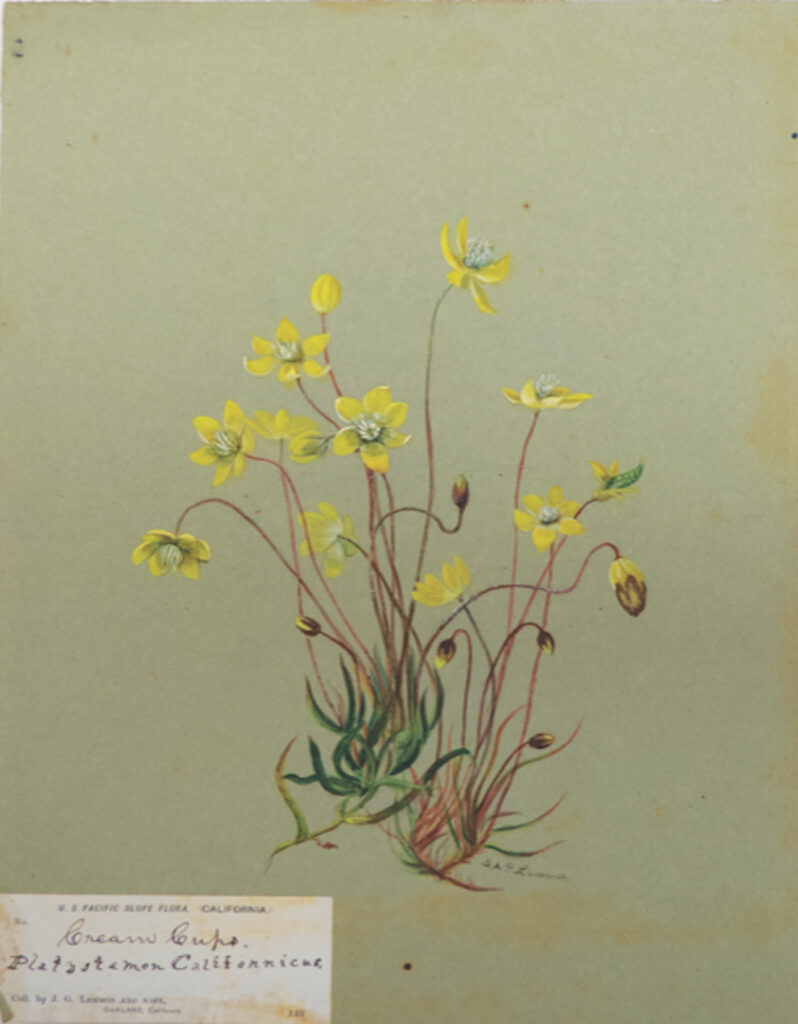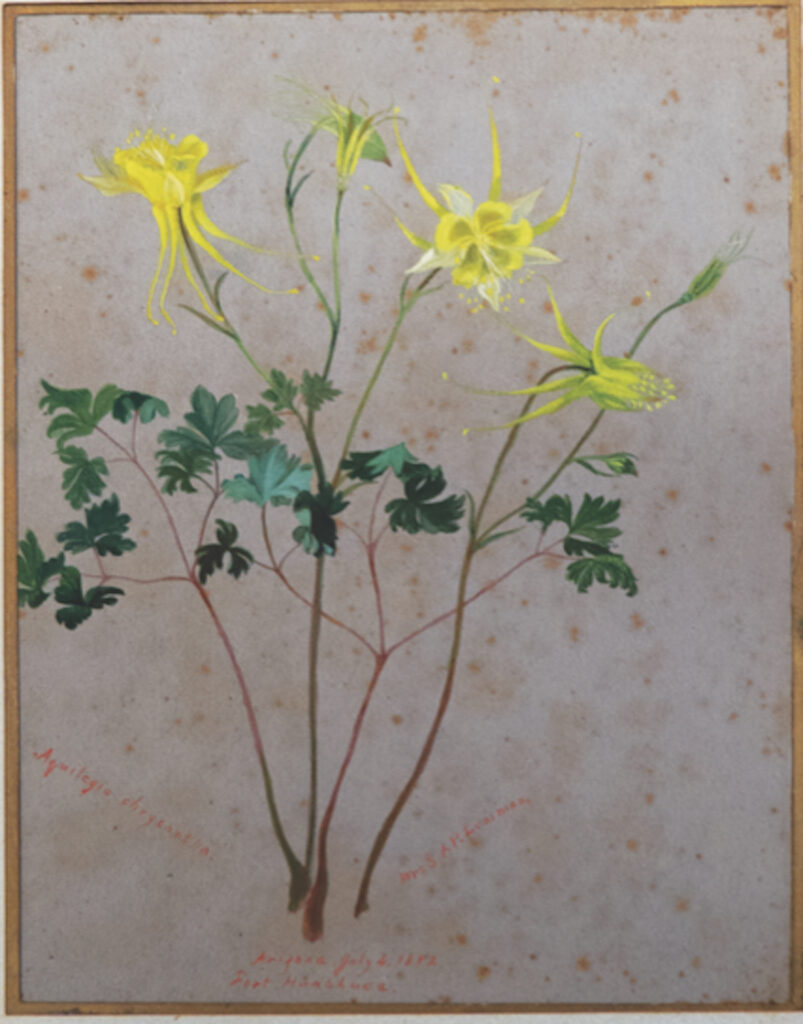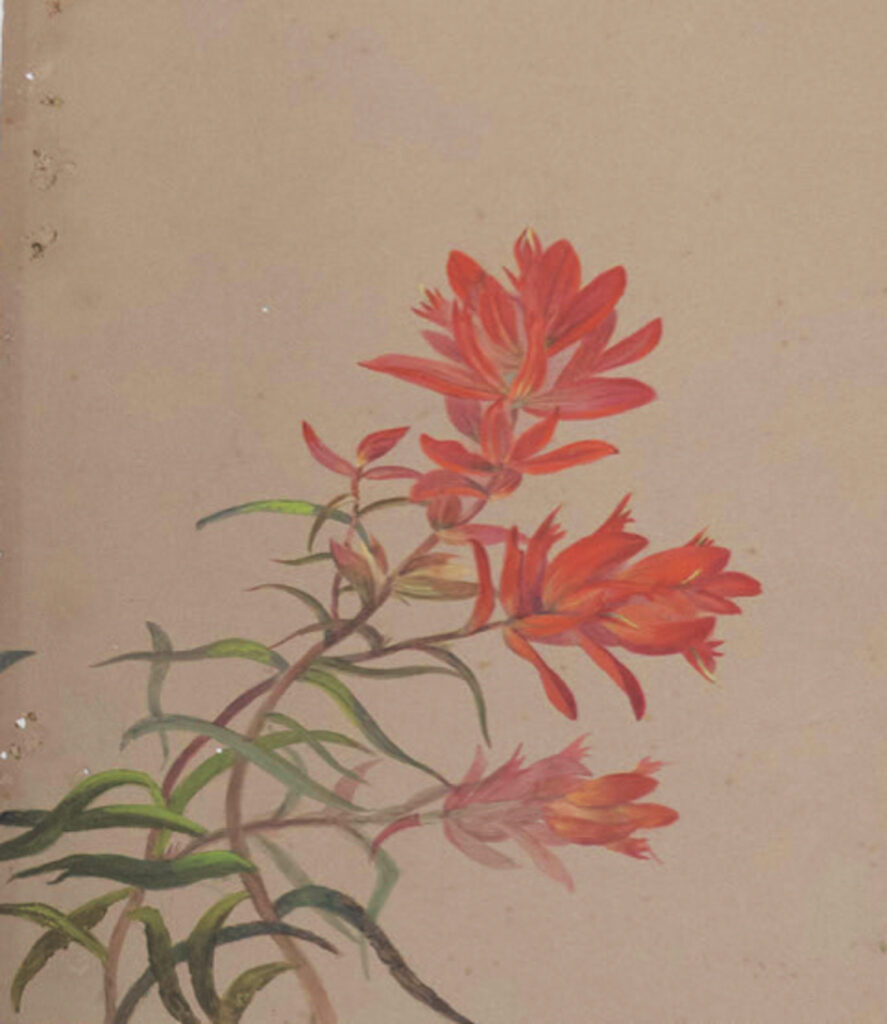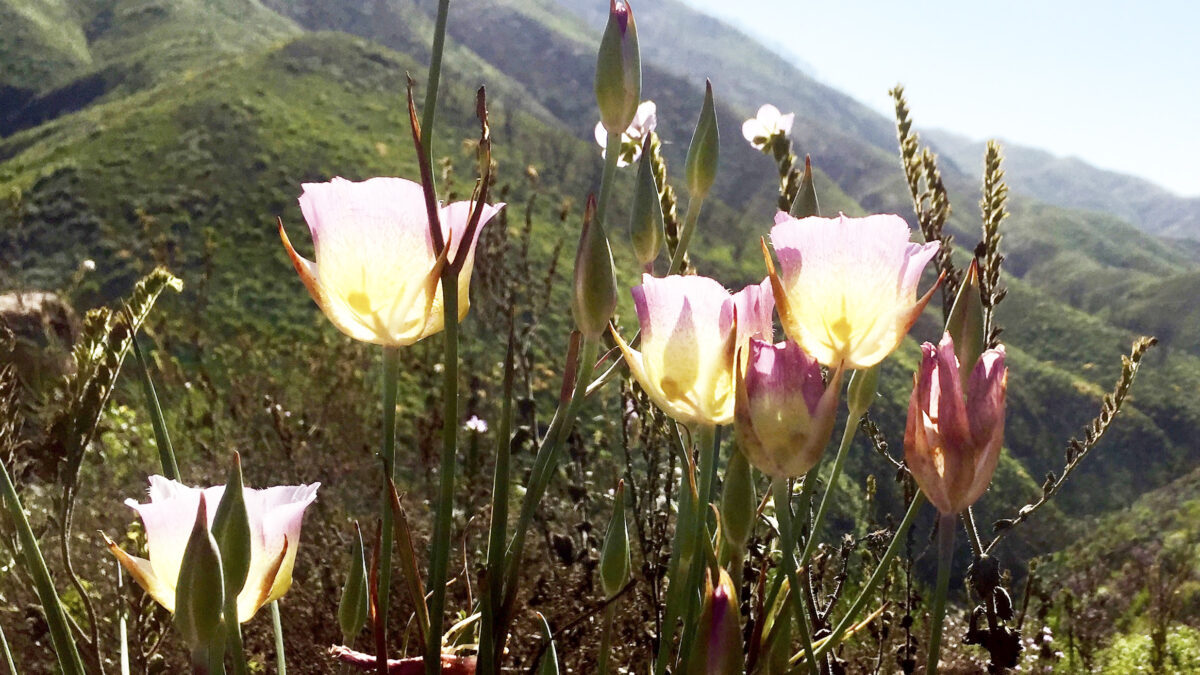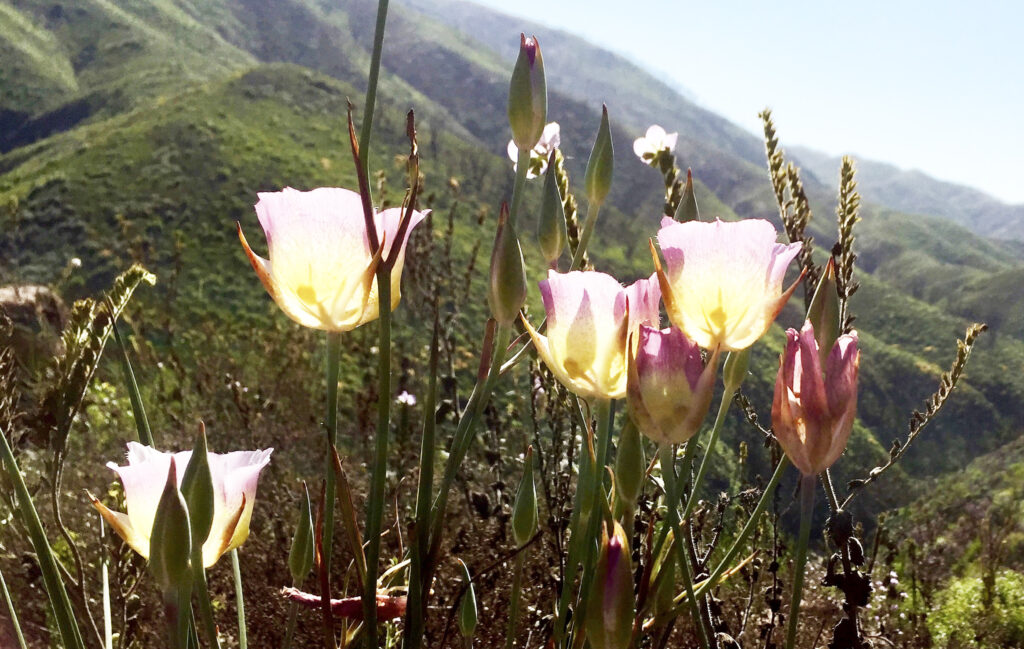
For a few short weeks in late spring and early summer, Calochortus plummerae, Plummer’s mariposa lily, blooms in the Santa Monica Mountains. It’s an increasingly scarce endemic species that grows only in a few areas in the transverse ranges along the California coast. Observant hikers may just see a Plummer’s mariposa lily or two blooming right now in the burn scar from the Palisades fire in Topanga State Park.
Seeing this flower is an uncommon joy, but in the summer after the 2018 Woolsey fire, this rare and beautiful flower bloomed throughout the burn zone, its cup-like blossoms growing from barren ground after most other wildflowers had gone to seed.
Plummer’s mariposa is so rare that the California Native Plant Society lists it as “fairly endangered,” but that year, it grew out of the scorched earth in abundance.
I had never before encountered this rare flower before, and I was enchanted, but I wondered how this spectacular blossom received such a prosaic name. It turns out there’s nothing ordinary about the name, or the woman it honors.
Calochortus plummerae was described and named by Edward Lee Greene, the curator of the herbarium at the California Academy of Sciences and the first professor of botany at the University of California, Berkeley. Sara Allen Plummer Lemmon, the woman he honored with the name, was a brilliant, tough, determined nineteenth century New Englander who became a respected American botanist, was as remarkable as the flower named for her.
I wrote about Sara and the lily named for her in 2019. That article led me to Wynne Brown, who was writing a biography on Sara. In 2021, she published her book: The Forgotten Botanist: Sara Plummer Lemmon’s Life of Science and Art.
In the book, Brown chronicles Sara’s extraordinary life as an explorer, mountain climber, scientific illustrator and botanist, a life lived in an era when women weren’t supposed to do any of those things, let alone all of them. Sara studied ferns, marine botany, algae, and trees, identifying new species and writing monographs on her observations. She also created hundreds of illustrations, becoming the official illustrator for the California State Board of Forestry for several years and lectured on forest conservation, and she campaigned for nearly 10 years to make the golden poppy the state flower of California, finally succeeding in 1903.
Before she married botanist John Lemmon—in 1880 at the age of 44—and began her own career as a botanist, Sara studied chemistry and physics, and won a three-year scholarship to Cooper Union for the Advancement of Science and Art, a progressive college in New York City that was “open to all.” She volunteered as a nurse during the Civil War, then traveled to California alone and settled in Santa Barbara, where she started one of the state’s first lending libraries. She also established a nursing school; became one of the founders of the Pacific Slope branch of the Red Cross. She was the second woman ever invited to join the California Academy of Sciences.
Sara’s biographer is a writer, illustrator and professional editor. Wynne has worked on numerous book projects, but this one was different, and it would change the trajectory of her life.
“I learned that Mount Lemmon in Arizona was named for a woman botanist. She was one of the only women ever to have a mountain named after her,” Wynne told me, describing the beginning of her surprising journey.
Wynne encountered Sara again while researching other pioneering women in the early 2000s. She learned that there were six linear feet of correspondence, field notes, photographs and other material on and by Sara and her husband at the University and Jepson Herbaria Archives in Berkeley. “I itched to see that material,” she writes in the preface to her book. When she finally had an opportunity to see the material, she knew it was a treasure. She traveled to Berkley several times from her home in Arizona, photographed 1,400 pages of letters, and set to work reading about and reconstructing Sara’s life.
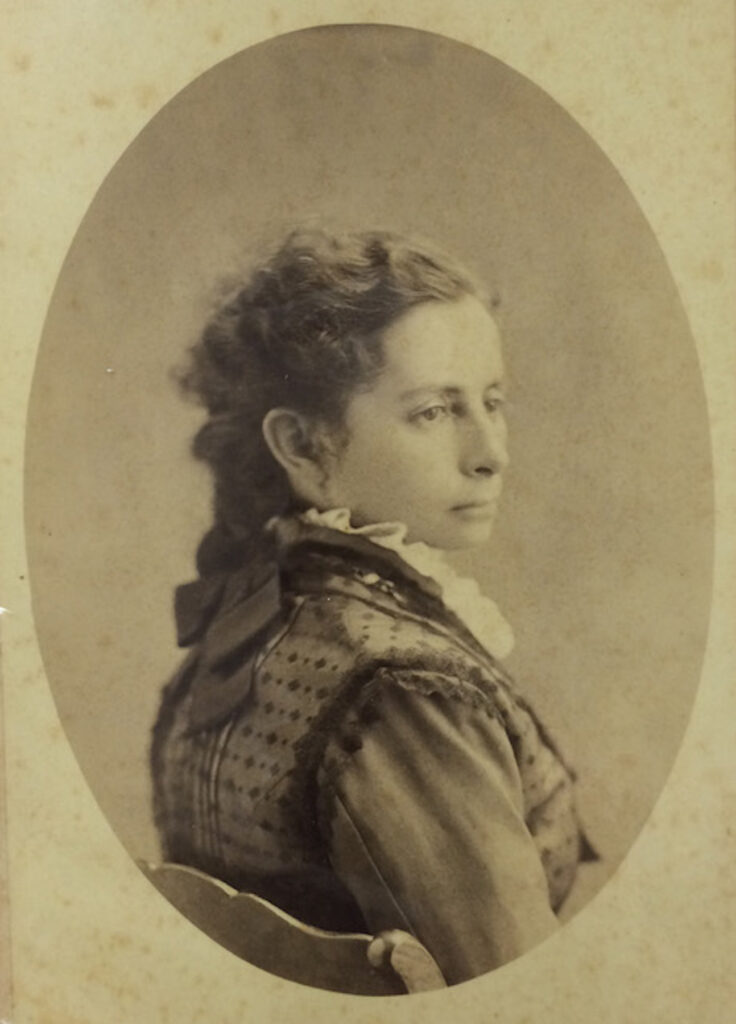
Sara was a prolific, engaging, and detailed letter writer who corresponded regularly with her family, including her father and sister, but many of her letters were written in “cross writing,” each page of writing written over at a right-angle to save paper. Deciphering the writing was a challenge.
Wynne found that the Herbaria Archives was also home to a handful of Sara’s surviving artwork—delicate watercolor studies of the plants Sara and her husband collected.
“Sara was considered one of the most accurate painters of nature in the State,” Wynne said. “But most of her scientific illustrations were thought to have been lost in the 1906 San Francisco earthquake.”
Most, but not all. In 2017, two boxes of sketches and drawings made during a botany expedition to Arizona in 1884 were rediscovered while Wynne was researching for her book. The collection belonged to Sara’s great grandnephew Harold St. John, who was a noted botanist at the University of Hawaii. After his death, his granddaughter donated the boxes to the Herbaria Archives. The artwork was so fragile that it was almost impossible to handle and the archives had no money for an archivist, but Wynne was determined to find a way to document the material.
To get the photos for her book, she hired Susan K. Filter, a highly respected conservator. For one full day of research, Wynne and her husband Dave assisted Susan in the painstaking process of extricating and photographing each piece—front and back. There were a total of 276 pieces of artwork, many of them delicate watercolor paintings on toned paper, their colors still vibrant despite serious damage. Most of the artwork has moisture damage and some papers were almost entirely consumed by insects.
“The insects liked the paper but not the paint,” Wynne said. “They left what looked like lace cutouts.”
Wynne describes the astonishment she felt as Filter carefully extracted one extraordinary artwork after another from the jumbled contents of the boxes. “Exquisite and tragic,” she said.
The artwork was clearly too fragile to be handled by anyone other than an expert, and there was no way to safely exhibit the originals, but a selection of photos of the paintings became the centerpiece of Brown’s book, and she resolved to find a way to preserve the work and make it available to other researchers.
In December, a month after her book was published, Wynne gave a presentation to the Sabino Canyon Volunteer Naturalists in Saguaro National Park in Arizona, right at the base of Sara’s mountain, Mount Lemmon. The next day, the organization invited her back to present a proposal on what it would take to preserve Sara’s work.
The nonprofit organization raised $3,500 for the project. An anonymous contributor donated another $1,000. It may not sound like much, but it was enough to get started.
The project has drawn conservator Susan Filter out of retirement. She, Wynne, Dave, and the archive’s staff will begin the delicate difficult process of rehousing the first 30 pieces of artwork. Protecting and stabilizing more of the works will have to wait for more funding, but it’s an important beginning.
“Sara is a significant hidden figure in both art and science,” Wynne said, adding that she is determined to make it possible for Sara’s work to be seen by researchers and interested members of the public anywhere in the world.
The Forgotten Botanist: Sara Plummer Lemmon’s Life of Science and Art, by Wynne Brown is published by the Bison Press, an imprint of the University of Nebraska Press, and is available from www.nebraskapress.unl.edu or from Amazon.com
Contributions to the preservation effort are welcome—time is running out for these beautiful but rapidly deteriorating original works. Learn more about Sara Plummer Lemmon, and author Wynne Brown’s effort to conserve her artwork and document her life at wynnebrown.com.
